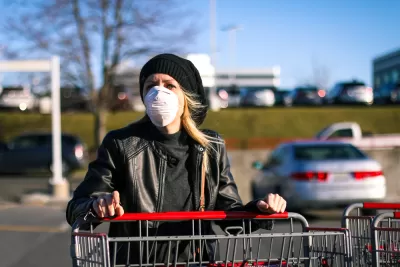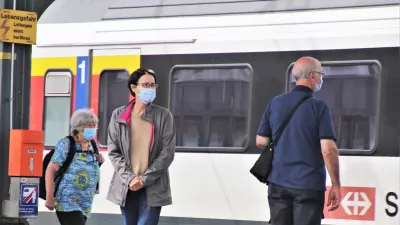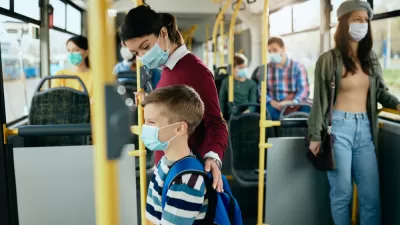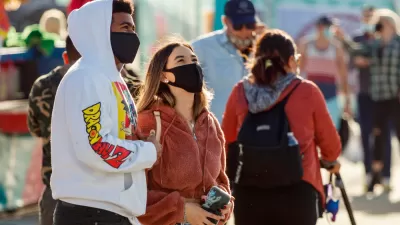Blue states have joined red ones in ending masking orders as COVID cases plummet, but the Centers for Disease Control and Prevention is sticking to its guidance: where transmission is 'high' or 'substantial,' universal indoor masking is recommended.

COVID cases are dropping dramatically in all but two territories in the U.S. on Feb. 9, down 63% in the last two weeks to a 7-day daily average of <230,000 cases, or 69 per 100,000 people, according to The New York Times coronavirus tracker. The Covid Act Now tracker on Feb. 10 shows that the infection rate, or R(t), is below 1 in all but one of its 53 jurisdictions, meaning the trajectory is downward everywhere save the Northern Mariana Islands.
That trajectory has contributed to the decision by many Democratic governors to lift their state's masking orders, as NBC News reported on Tuesday, Feb. 8:
Connecticut, Delaware, New Jersey and Oregon announced Monday that masks will soon no longer be required in schools. California Gov. Gavin Newsom will let the state’s indoor masking mandate end for vaccinated people on Feb. 15, although schoolchildren and the unvaccinated will still need to wear masks.
Bloomberg News reports on Wednesday that "New York Governor Kathy Hochul is lifting a mask mandate for businesses that don’t check Covid-19 vaccination status, citing high inoculation rates and low transmissions across the state."
NBC Chicago reports on Feb. 9 that "Gov. J.B. Pritzker announced Wednesday that the state plans to end its mask mandate for most indoor spaces by Feb. 28, with schools and health care facilities following suit at a later date." Massachusetts Gov. Charlie Baker, a Republican, announced the same day that masks will no longer be required in schools as of Feb. 28, reports the Boston Globe.
Coronavirus transmission
However, transmission, as measured in daily new cases, is high virtually everywhere in the U.S., as Rochelle Walensky, the director of the U.S. Center for Disease Control and Prevention (CDC), told Reuters on Tuesday.
"Now is not the moment to drop mask mandates in schools and other public places," Walenksy said in an interview, wrote Julie Steenhuysen and Carl O'donnell on Feb. 8. According to Walensky,
I know people are interested in taking masks off. I too am interested. That would be one marker that we have much of the pandemic behind us.
We have and continue to recommend masking in areas of high and substantial transmission - that is essentially everywhere in the country in public indoor settings.
Pandemic déjà vu
We've been here before—more than once, in fact. "High and substantial transmission" is the metric that the CDC applied to its recommendation for universal indoor masking (regardless of vaccination status) when it revised its masking guidance last summer after data from Provincetown, Mass. showed massive breakthrough infections.
[Scroll down to the section titled, "Do you live in an "area of substantial or high transmission?" in the post, "Delta Variant's High Transmissibility Prompts CDC to Issue Masking Correction," August 2, 2021.
. Two metrics are used to determine the level of transmission:
- Weekly new cases per 100,000 people, aka case incidence
- COVID-19 test positivity rate (TPR)]
CDC's COVID-19 Integrated County View map shows that for the week ending Feb. 9, 98.7% of counties are experiencing high transmission, 0.65% substantial transmission, 0.12% moderate transmission, and 0.5% low transmission.
Current CDC guidance
As of Aug. 12, 2021, CDC recommends that to "Slow the Spread of COVID-19, people, including children older than 2, should wear a mask in indoor public places if they are:
- Not fully vaccinated
- Fully vaccinated and in an area with substantial or high transmission
- Fully vaccinated and with weakened immune systems
Next steps
POLITICO reports on Wednesday that CDC is considering using other metrics, such as hospital capacity, to influence its masking guidance.
On a more general level, NBC News reports on Friday on the difficulties the administration is having from shifting from President Biden's promise as a candidate to "shut down the virus" to living with it.
Related in Planetizen:
Hat tip to Kaiser Health News Morning Briefings: Feb. 9 and Feb. 10.
FULL STORY: U.S. CDC stands by K-12 school masking guidance as states relax rules –Walensky

Trump Administration Could Effectively End Housing Voucher Program
Federal officials are eyeing major cuts to the Section 8 program that helps millions of low-income households pay rent.

Planetizen Federal Action Tracker
A weekly monitor of how Trump’s orders and actions are impacting planners and planning in America.

Ken Jennings Launches Transit Web Series
The Jeopardy champ wants you to ride public transit.

Washington Legislature Passes Rent Increase Cap
A bill that caps rent increases at 7 percent plus inflation is headed to the governor’s desk.

From Planning to Action: How LA County Is Rethinking Climate Resilience
Chief Sustainability Officer Rita Kampalath outlines the County’s shift from planning to implementation in its climate resilience efforts, emphasizing cross-departmental coordination, updated recovery strategies, and the need for flexible funding.

New Mexico Aging Department Commits to Helping Seniors Age ‘In Place’ and ‘Autonomously’ in New Draft Plan
As New Mexico’s population of seniors continues to grow, the state’s aging department is proposing expanded initiatives to help seniors maintain their autonomy while also supporting family caregivers.
Urban Design for Planners 1: Software Tools
This six-course series explores essential urban design concepts using open source software and equips planners with the tools they need to participate fully in the urban design process.
Planning for Universal Design
Learn the tools for implementing Universal Design in planning regulations.
Heyer Gruel & Associates PA
Ada County Highway District
Institute for Housing and Urban Development Studies (IHS)
City of Grandview
Harvard GSD Executive Education
Toledo-Lucas County Plan Commissions
Salt Lake City
NYU Wagner Graduate School of Public Service





























